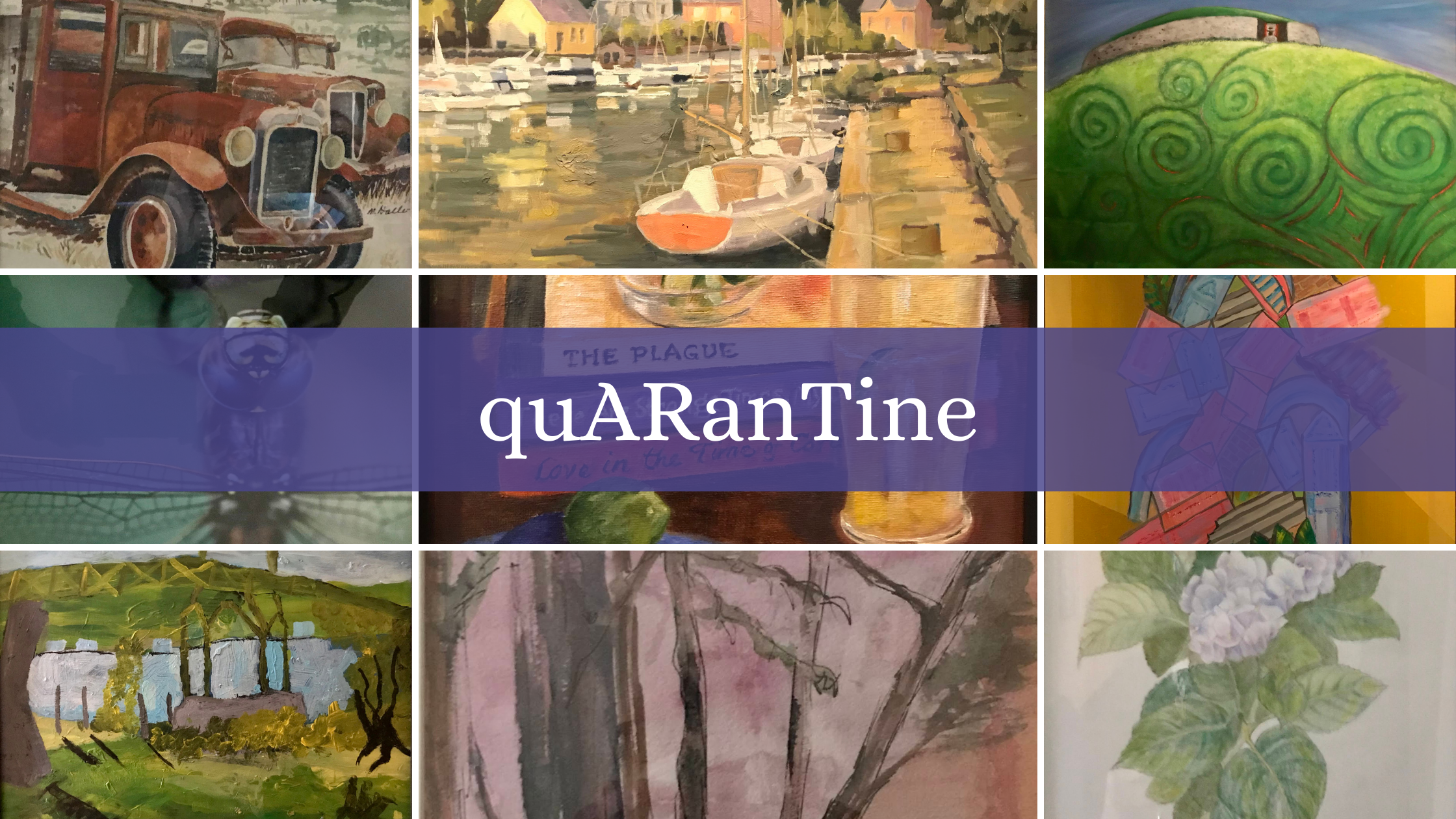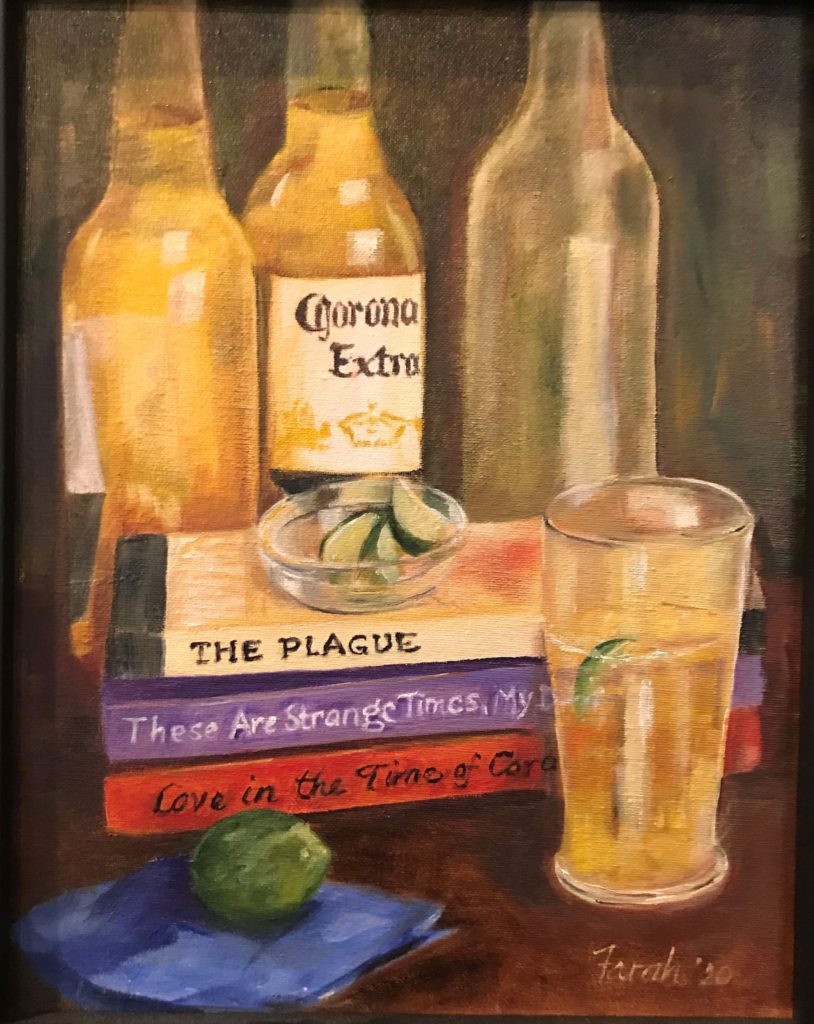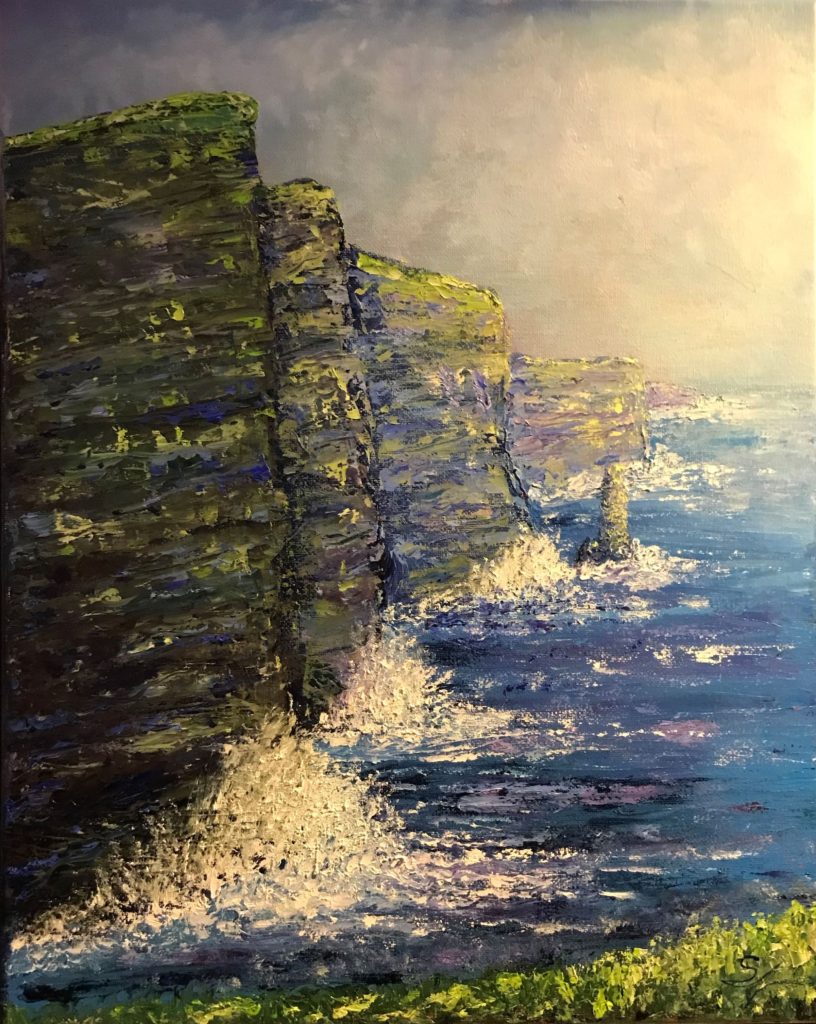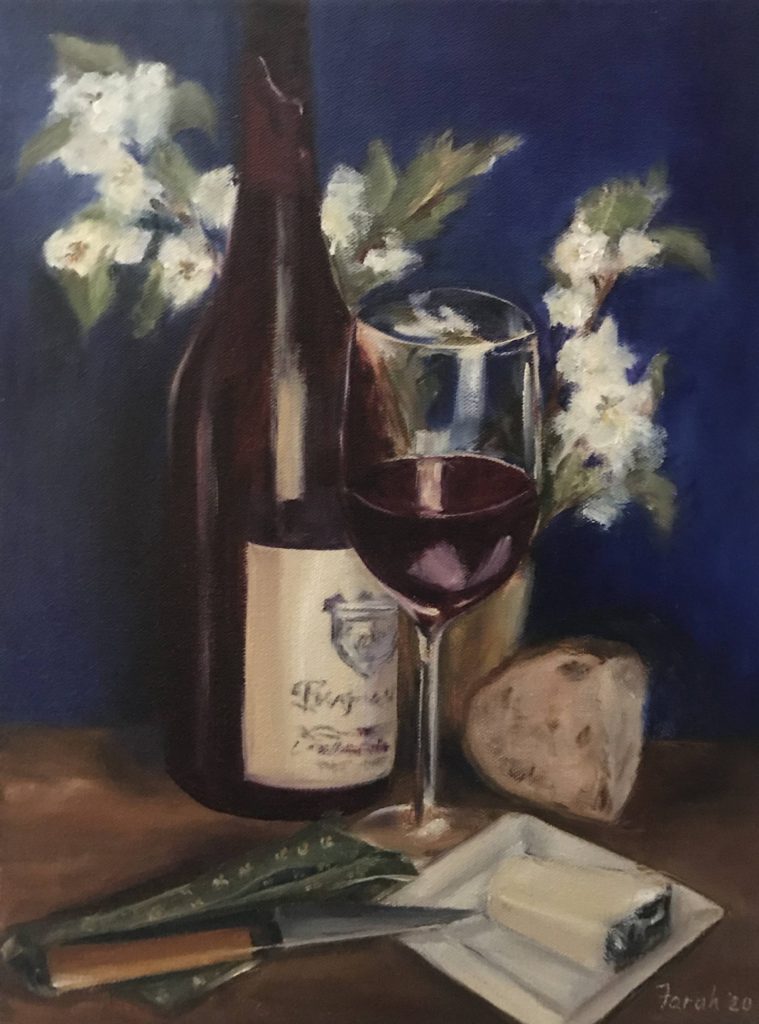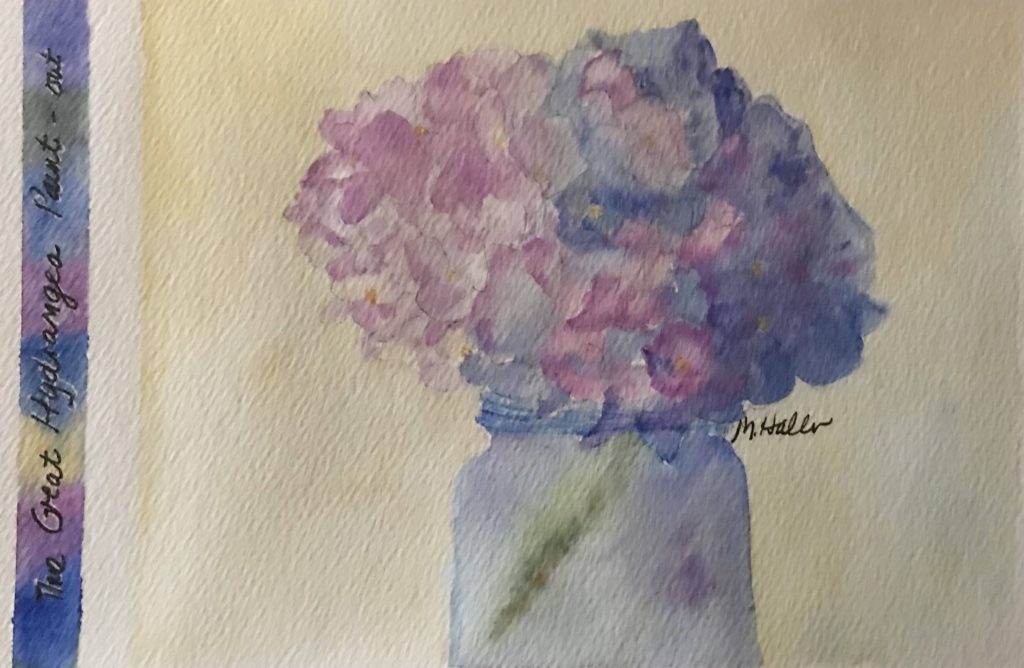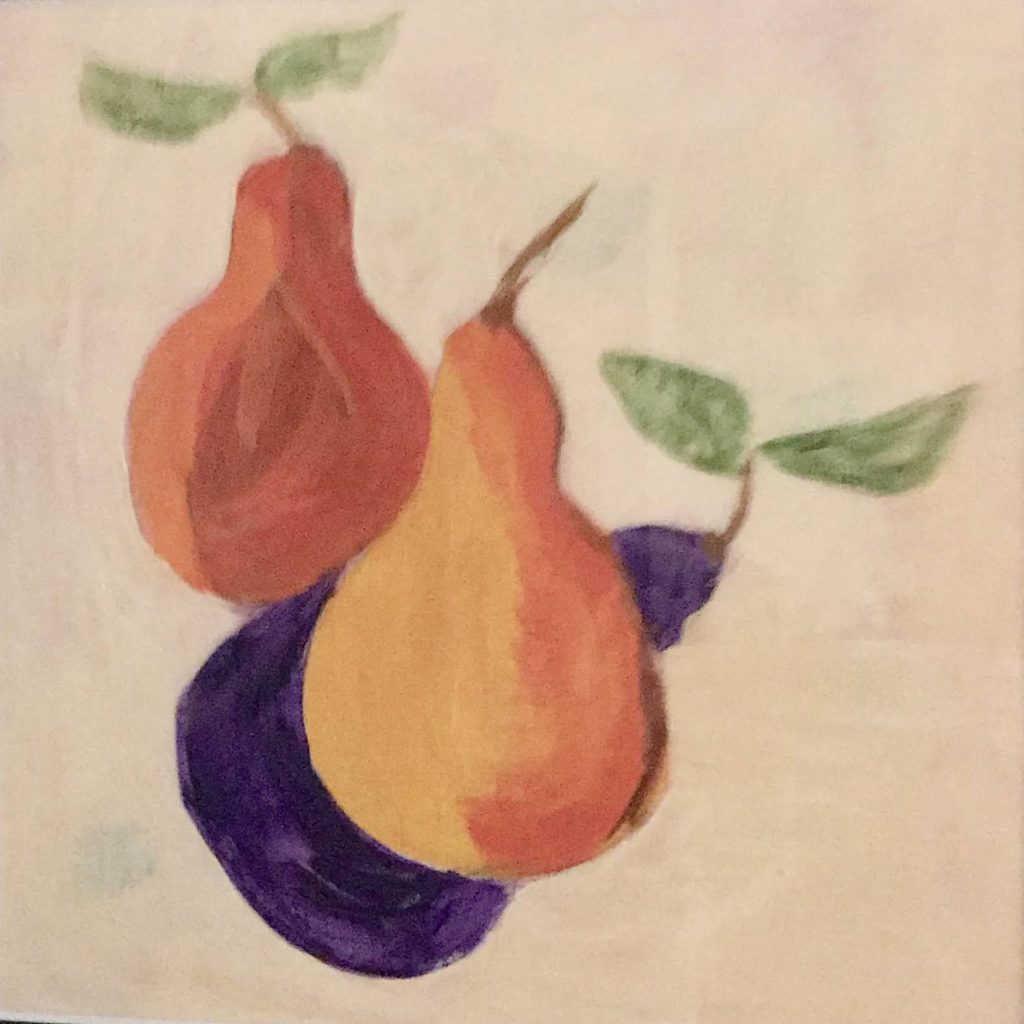About the Show
Since early March 2020 this has been a time like no other any of us have ever experienced – worldwide pandemic and its resulting isolation, tremendous social reckoning and unrest, devastating fires with choking smoke, and a contentious election. Alexa – change to 2021 !
The work being exhibited in this show was created during this spring, summer, and fall of 2020, while pandemic restrictions prevented us from being in the church building and being together, in person, in the Cloisters Art Studio.
Although the church was closed during all this time, the Cloisters Art Studio group continued to meet, virtually, to maintain our sense of community as well as our artistic skills. We meet weekly on Zoom to share art we have created, and to offer and receive constructive criticism. Some weeks we have suggested a challenge painting subject. We’ve had four outdoor plein-air sessions – Cathedral Park, Laurelhurst Park, Sally’s backyard, and the Columbia Gorge at Menucha.
We are so grateful for these opportunities because they have allowed us to stay connected with each other and with our church. In normal times we meet Wednesday afternoons, 4-7 p.m., in the Art Studio. The studio is available at other times as well. If you are interested in joining us, contact Sally at woolley7667@comcast.net.
And we want to remember our friend and exceptional creative spirit, Jeanne D’Archer, one of our most enthusiastic Art Studio participants.
The Art

Br’u na B’oinne (Newgrange)
A 5000-year old site north of Dublin in the Boyne Valley where tomb mounds are common. The spirals carved on the large entry stone are iconic in celtic designs. Oil on canvas, Sally Woolley
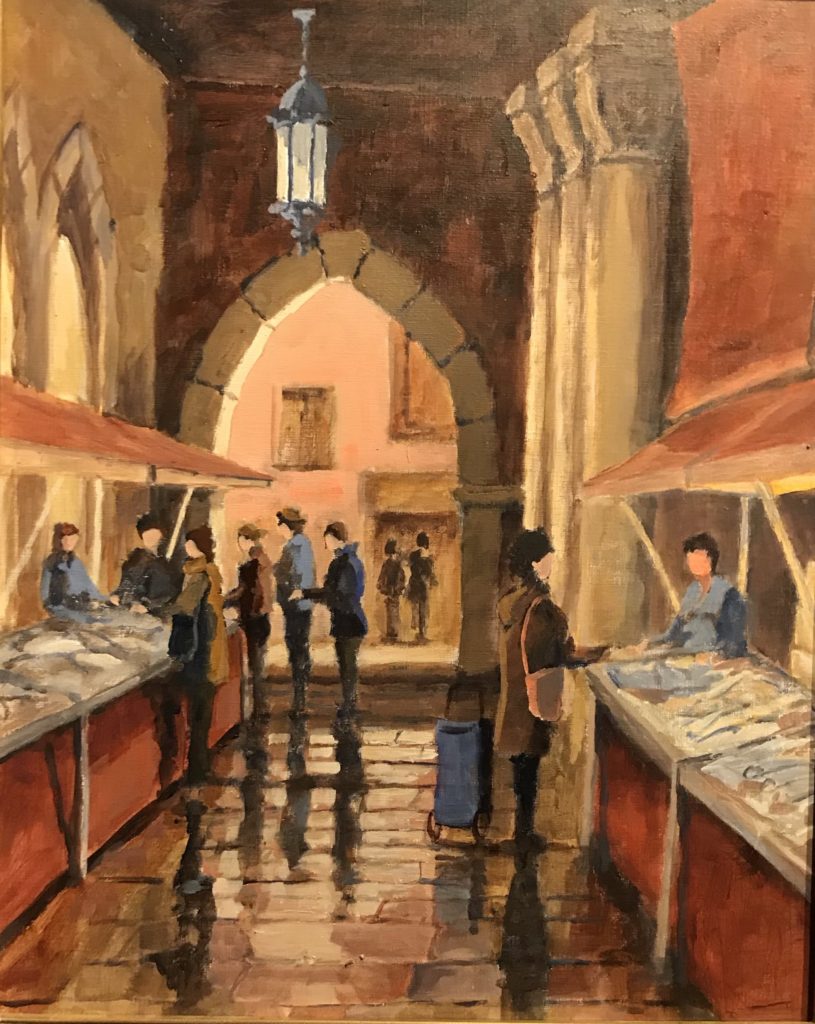
Venice Fish Market
Everyone in the art group seemed to have an opinion about this painting, from color, placement of the pillars, to overall composition. I followed their suggestions and the end result was a lot better. Acrylic, Jack Robinson
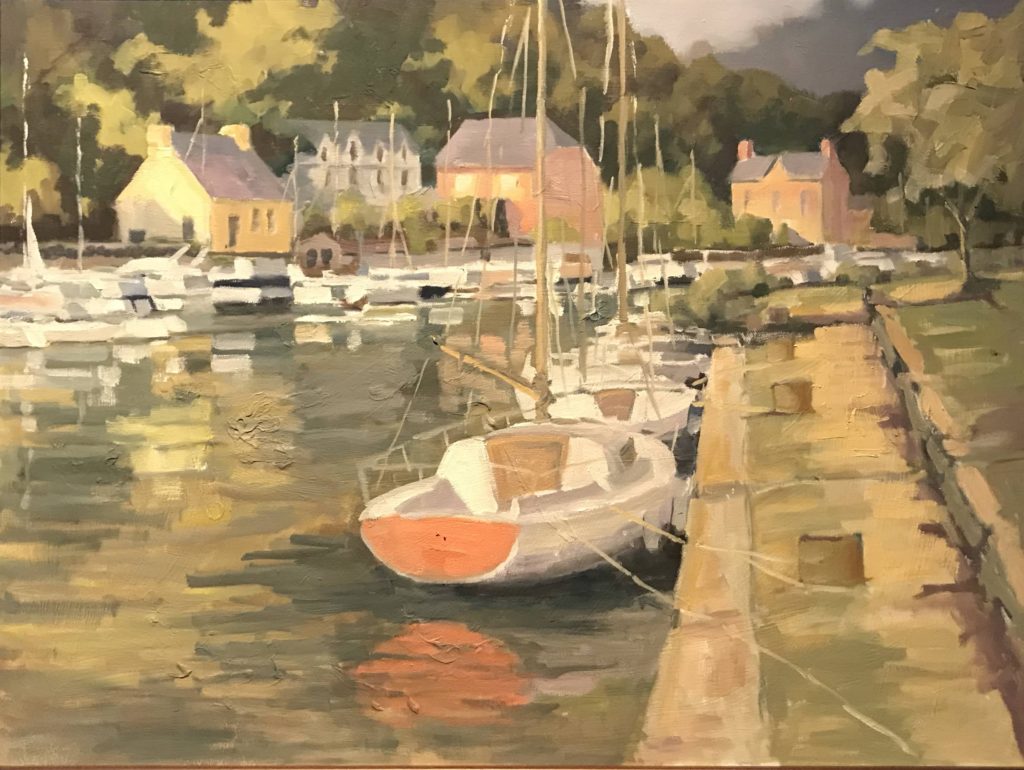
Port at Dinan, France
This is a new painting of a scene I painted in France two years ago. It’s brighter than the one I painted there. Input I received from the group on our weekly zoom calls significantly improved this painting. Acrylic, Jack Robinson
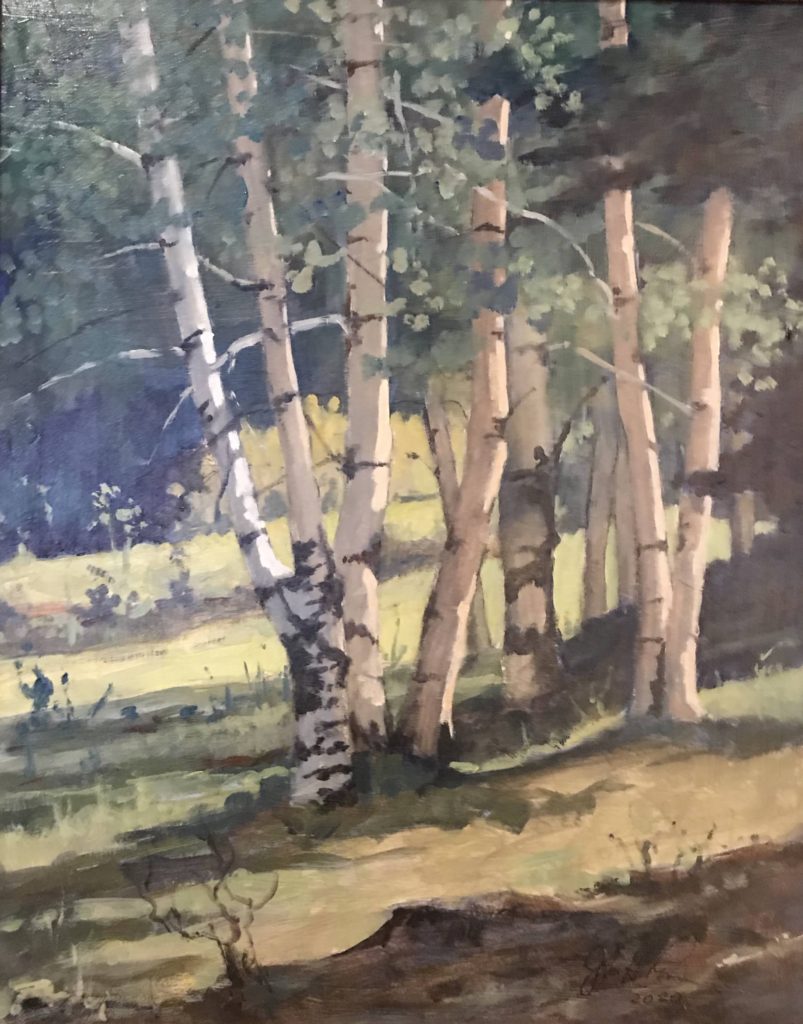
Aspen Grove
I painted this from a photo I took on my annual Robinson sibling trip to New Mexico. I especially like how the colors work together and the brush strokes. We missed our reunion this year because of Covid. Acrylic, Jack Robinson
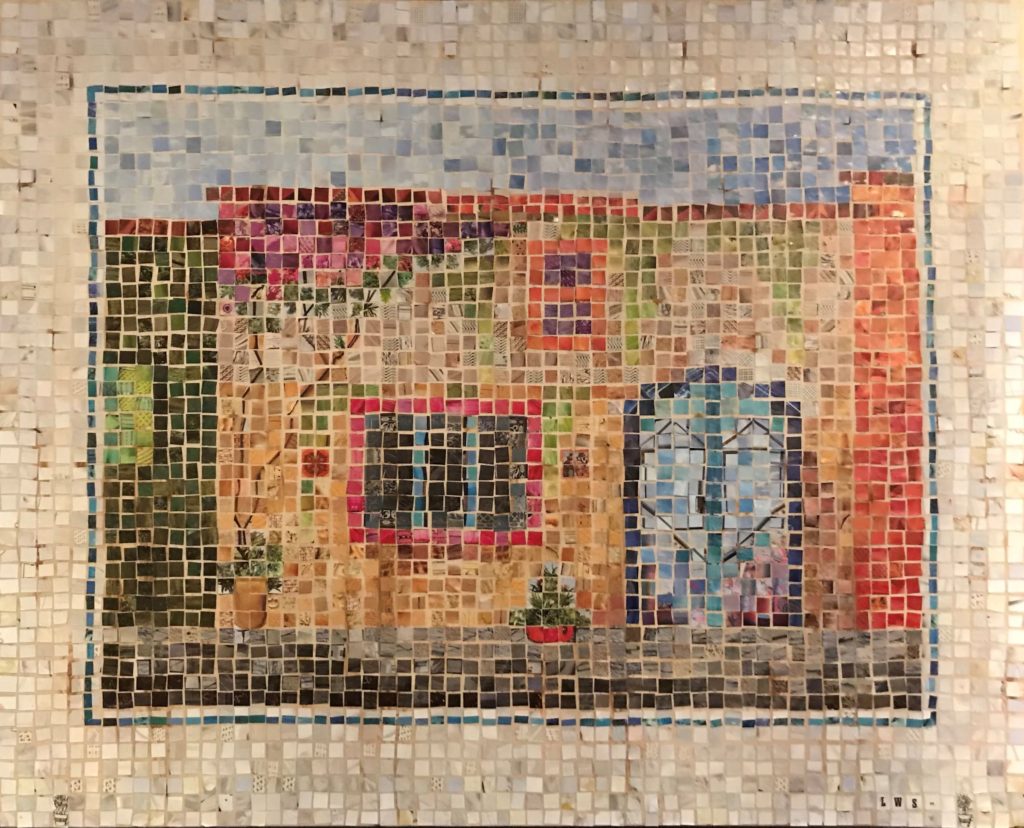
That House in Brazil, IV
For this paper mosaic/collage I decided to use a fixed grid as the base (as opposed to paper pieces of random shapes and sizes, overlapping, etc) and use tiles (tesserae) made from magazine ads and photos to create colors and gradations. Lewis Sprunger

That House in Brazil, VI
Colors were what caught my eye when I saw this house. What artist did (and did, and did) colors? Mark Rothko. Here, I’ve tried to play with the major colors of the exterior of the house – a la Rothko. The upstairs window (in my photos) has no glass, and the shutters are broken, revealing a pretty much trashed interior – most of which can only be otherwise guessed at. I surmised that some of the exterior colors must have suffused the interior spaces. And surely people lived there over the years – thus, the human form. Lewis Sprunger
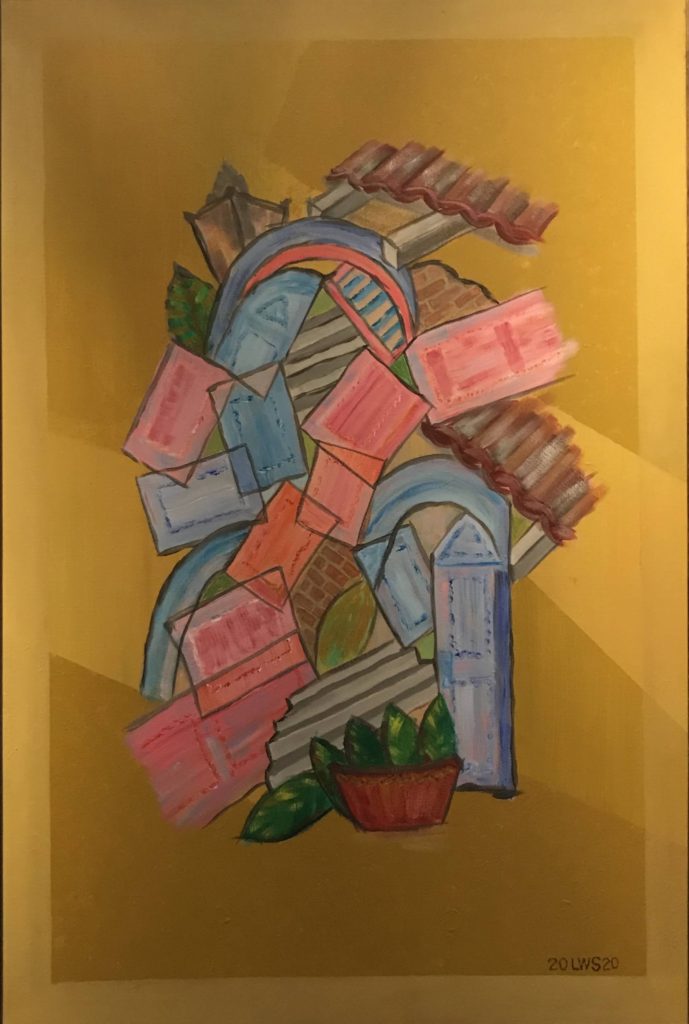
That House in Brazil, V
This is my attempt to reduce, reorder, reinvent, and recombine elements of the house into a cubist creation. Acrylic, Lewis Sprunger

Still Life
The most challenging part of this painting was the table cloth and how to create folds. Jack helped me put shadows in the right places. Once I laid the paint on and stood back to look at it, I was very surprised to see that, indeed, it looked like a fold in the cloth! Now I look at table cloths in other paintings with a greater appreciation. Arylic, Caroleigh Robinson
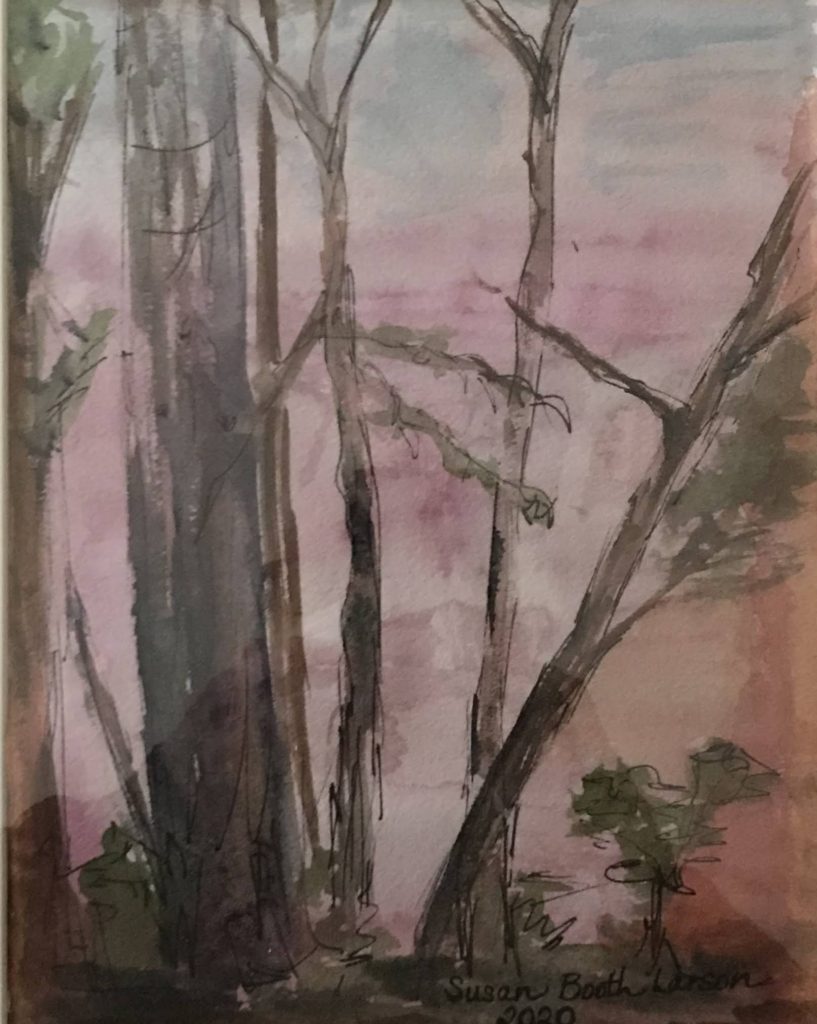
Path to Enlightenment
My time during the quarantine began with 5 months in the Bay Area, caring for my grandson. I painted lots of pictures– of salamanders, trains, and flying vehicles– in a style appropriate for a 3-year-old. No, I did not frame them! During one of my walks, I found a Buddhist Temple with a “Path to Enlightenment” trail that I enjoyed exploring. I had just lost my husband of 42 years and I was away from home in a new uncertain world, so I was looking for a new “enlightenment” for my life. I was alone on my own new “path” when I painted this melancholy view of the forest, representing my own melancholy view of my life. However, being in the woods, immersed in creating art, was a diversion from the abnormalities of the pandemic we were facing. P.S., I am still searching for enlightenment. Acrylic, Susan Booth Larson
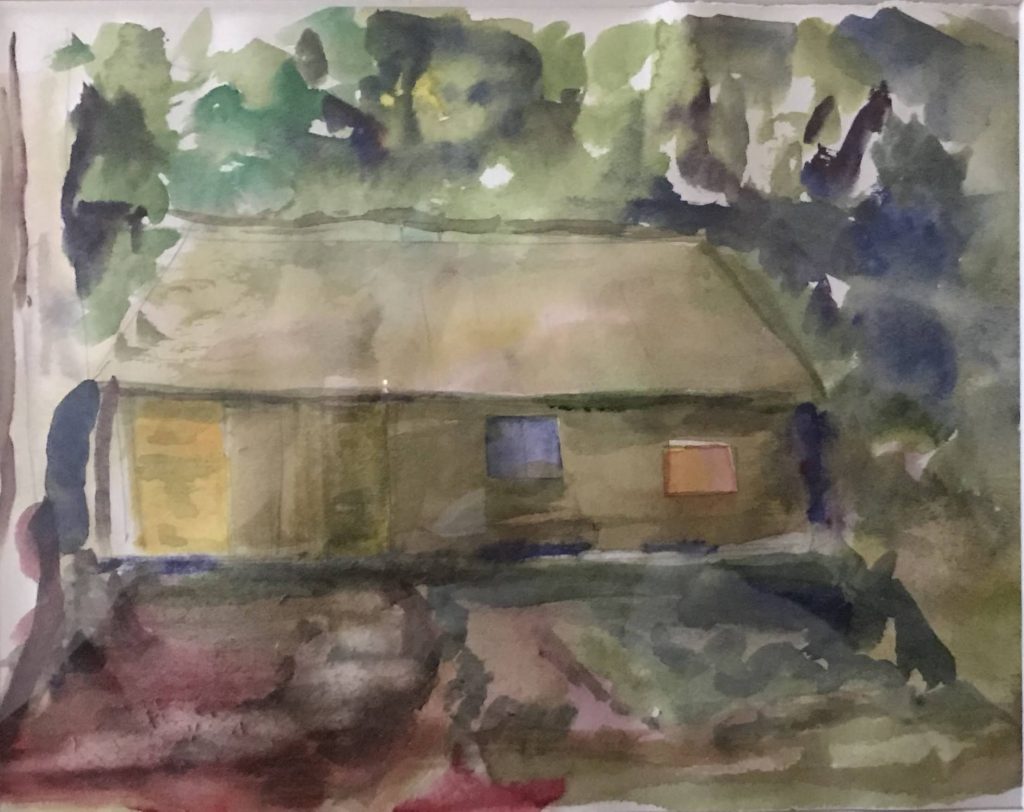
Cabin in the Woods
Last year David invited out studio group to spend a day painting in the woods at his friend’s cabin. Watercolor, David Slaughter
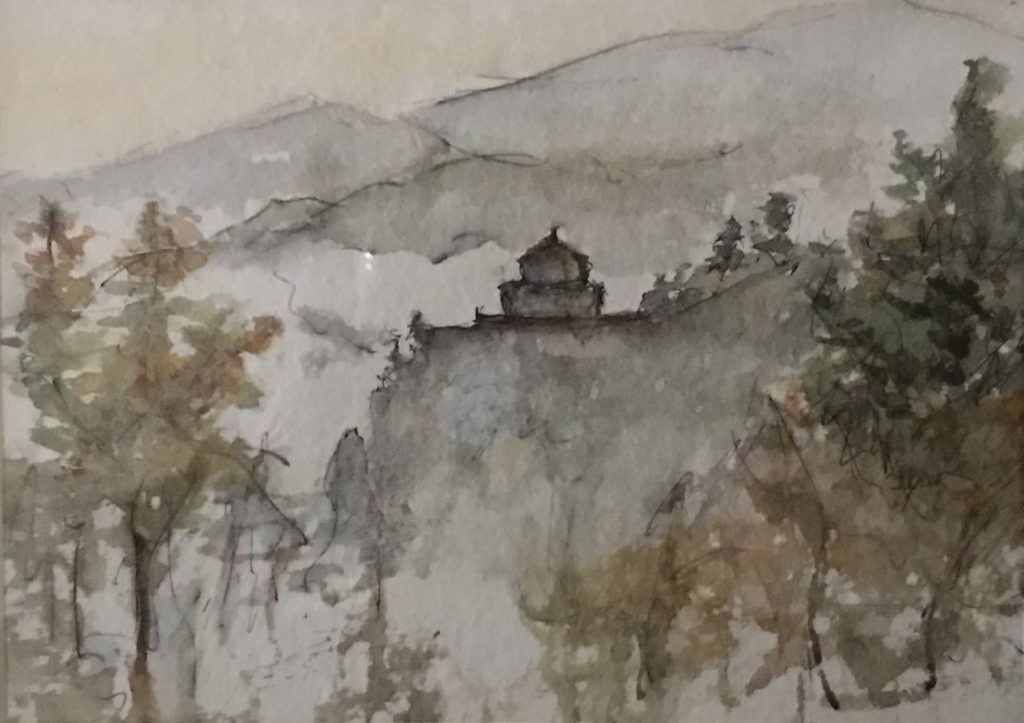
Overlooking the Gorge
The Studio Artist did a paint out at Menucha during the early fall—safely masked and socially-distanced.
Watercolor, Jackie Farah

The Gorge
When the painting group went to Menucha for a paint out I watched everyone work on sketches of the scene. Mine was awful so I just decided to jump ahead and begin to paint. I used a palate knife and a glob of purple paint and made a large swath of paint from the top of the canvas to the bottom. Then the same thing with orange and then green. Somehow it looked rather like hills and cliffs. I was encouraged. At home later Jack added the river and I finished the sky and a few other brushstrokes. I loved the texture of the knife – I did not use a brush in this painting. Acrylic, Caroleigh Robinson
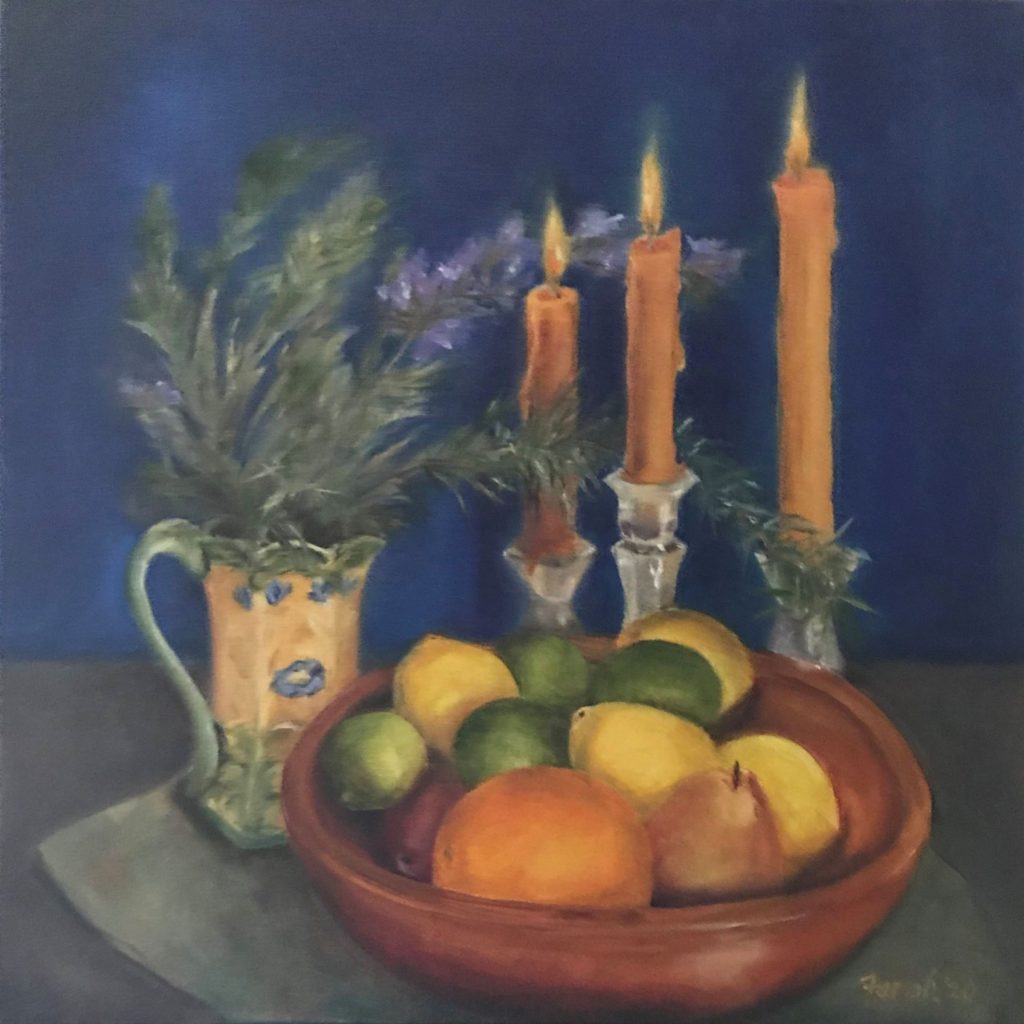
Lemons and Light
Painting is a meditative and creative time in my day, every day. With a brush in my hand, the outside world and its anxiety-producing jabber-jabber disappears. I can lose hours as well as the concerns of the day in the flow of color and shape. This painting is about finding brightness in the midst of what was at times rather dark. Oil, Jackie Farah
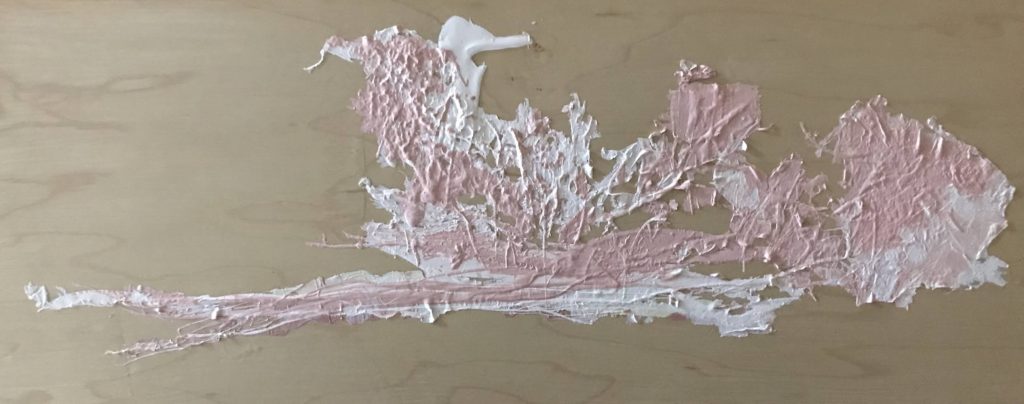
Abstract
I peeled the dried paint from the inside of the bucket I use when painting from a ladder. It came off in one piece. While it is displayed in the orientation most pleasing to me, there are other opinions. Semi-gloss latex enamel, Burt Reif
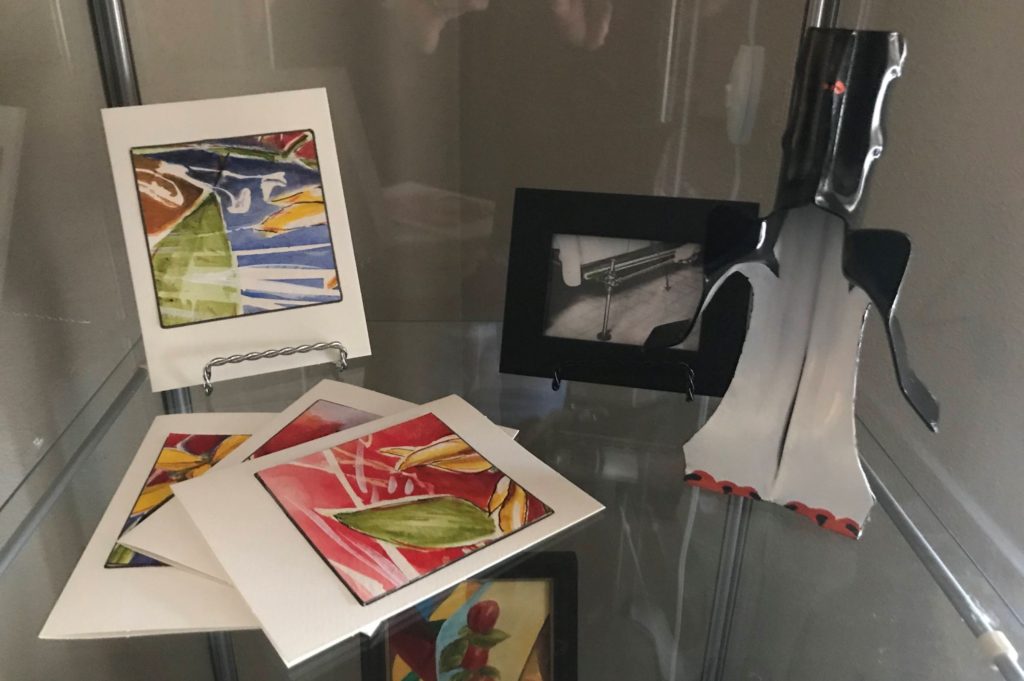
Penguin
It sat on the counter for a long time at the VW garage. I stood it on end, and saw a penguin. With a little help from the bench grinder and some paint, you can see a penguin too. VW Beetle jack receiver painted in enamel, Burt Reif
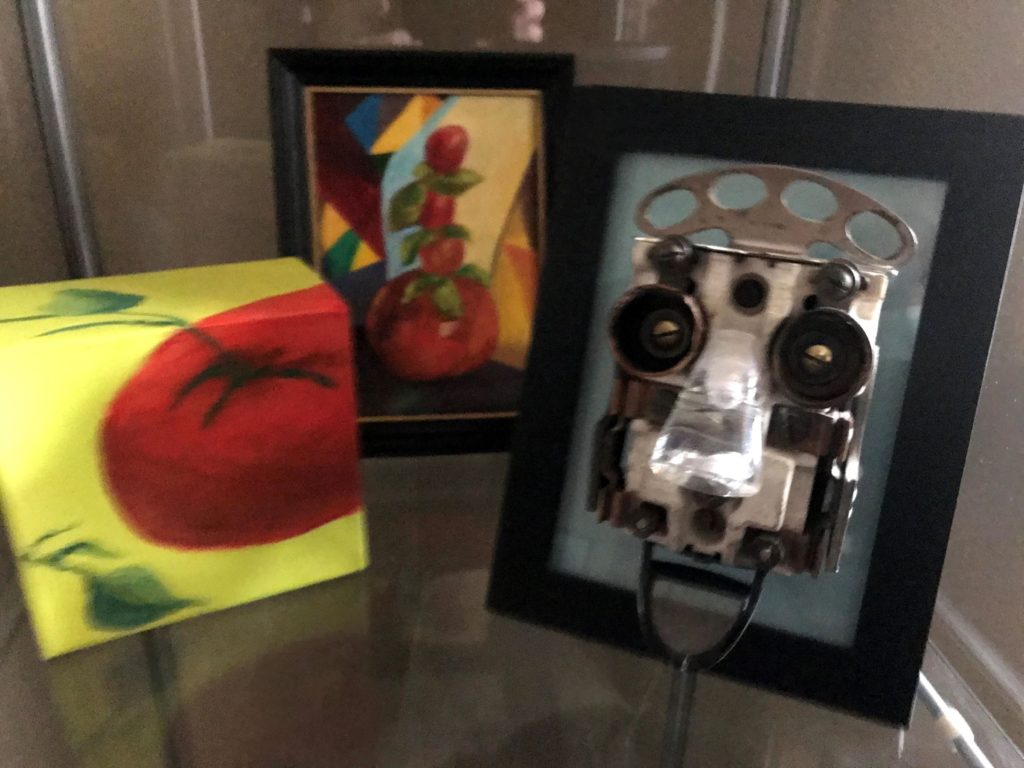
Tomato – I’m not sure why I bought the cube canvas but once I decided on the tomato subject it just sort of took off – vines and leaves found themselves on all sides. Chartreuse and vermillion – what could be better than that! Acrylic, Caroleigh Robinson
Tomatoes in Style – Response to two Studio Art Zoom challenges: “paint in an abstract style” and “paint a tomato.” Oil, Jackie Farah
Face – A household fuse holder mounted to a walnut block. Other features are epoxied to the fuse holder. His name is Art. Burt Reif
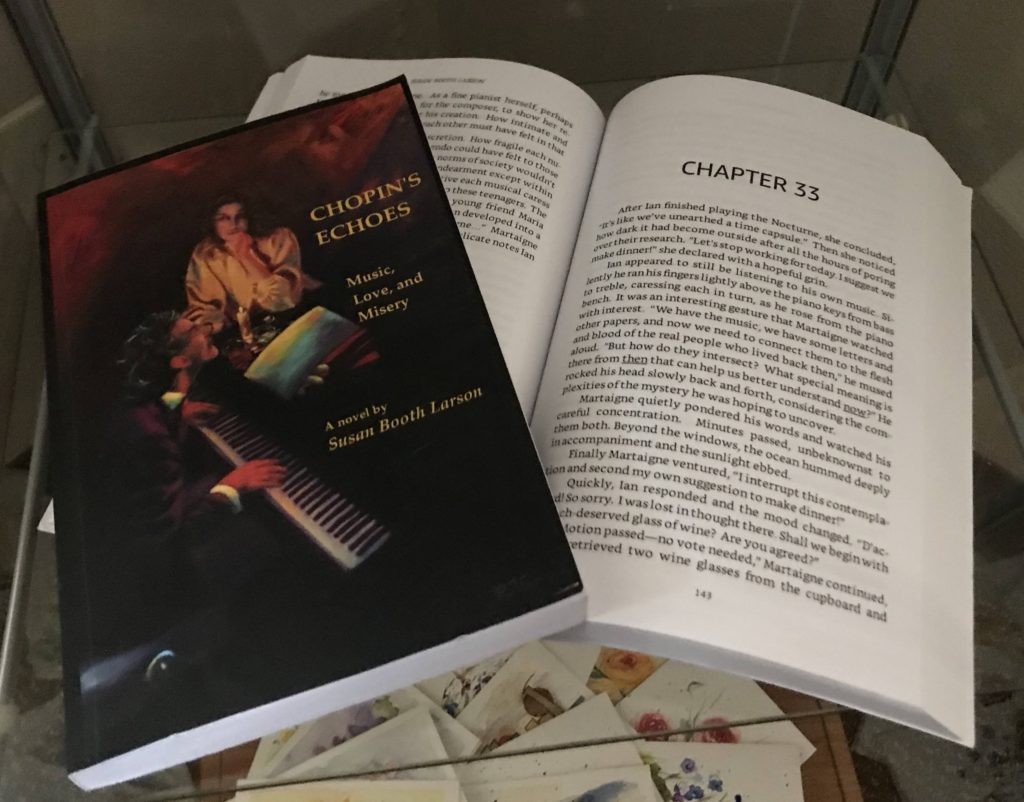
Chopin’s Echoes: Music, Love, and Misery, a Novel
After seven years of writing, rewriting, research, and being afraid to share my first novel with the world, I finally decided that I needed to accomplish “something” during the quarantine. I self-published it in June 2020 and was delighted that friends, family members and strangers liked it! I’m currently almost done with the “prequel” and have plans for a sequel after that. I love the adventure of creative writing, and my background in music rejoices that I can continue to work on “something” during this lonely quarantine. Susan Booth Larson
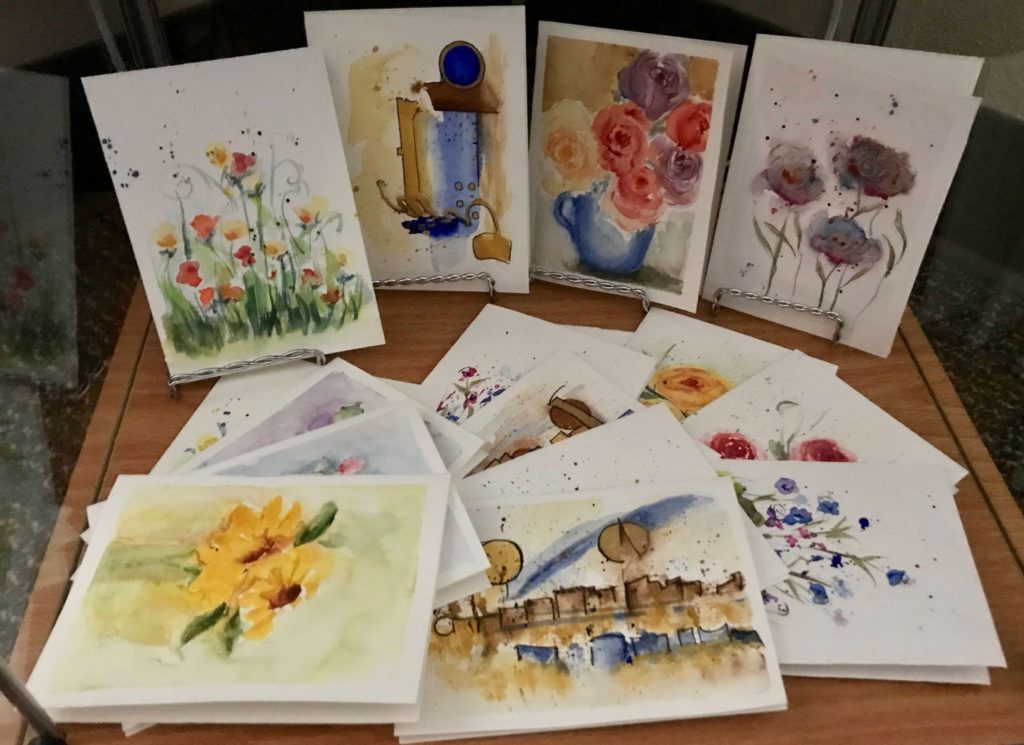
Cards and More Cards
I started studying and experimenting with watercolor mid-way through the lockdown, first postcards and greeting cards then with some larger pieces along the way. I
learned a lot from YouTube, internet classes and from several books I was driven to purchase by my enthusiasm for this new and very different medium. Watercolor, Jackie Farah
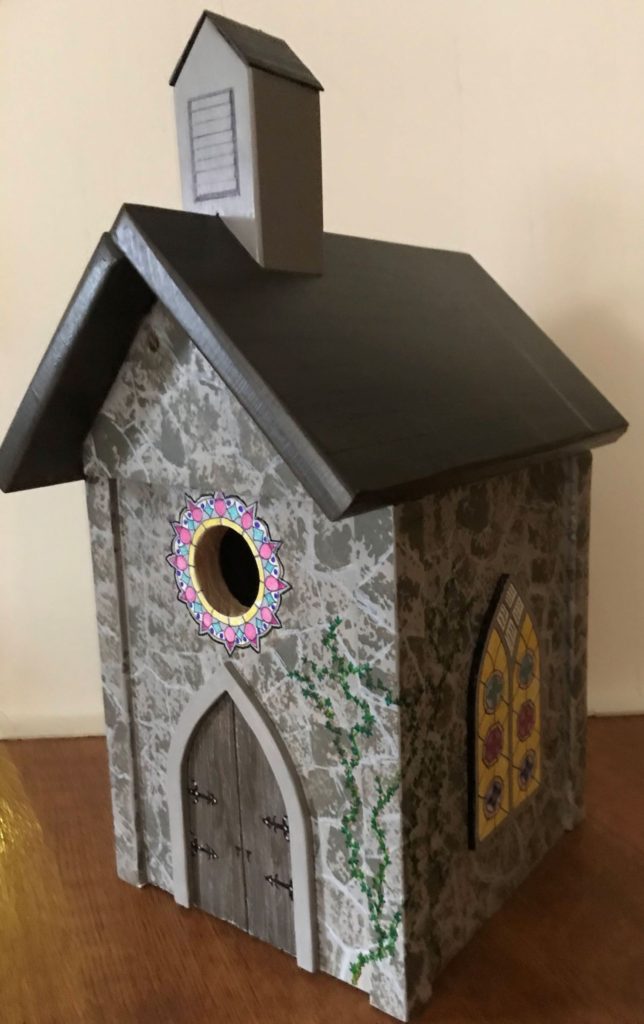
Church Birdhouse
This one became a church by accident, after I had arbitrarily cut the shape of the back/cleanout door. Then it seemed only natural to give several nods to Westminster’s building. I vaguely tried to give the impression of stone construction, and I used medallions similar to Westminster’s in the stained glass windows. Since the round bird entrance already made a circle above the front door, it was fun to give a hint of a rose window to it. The whole project careened along with improvisation all the way and was a joy to recklessly enjoy the process rather than plan ahead. Mixed media, cedar, acrylic house paint, sharpies, Cynthia Bauer
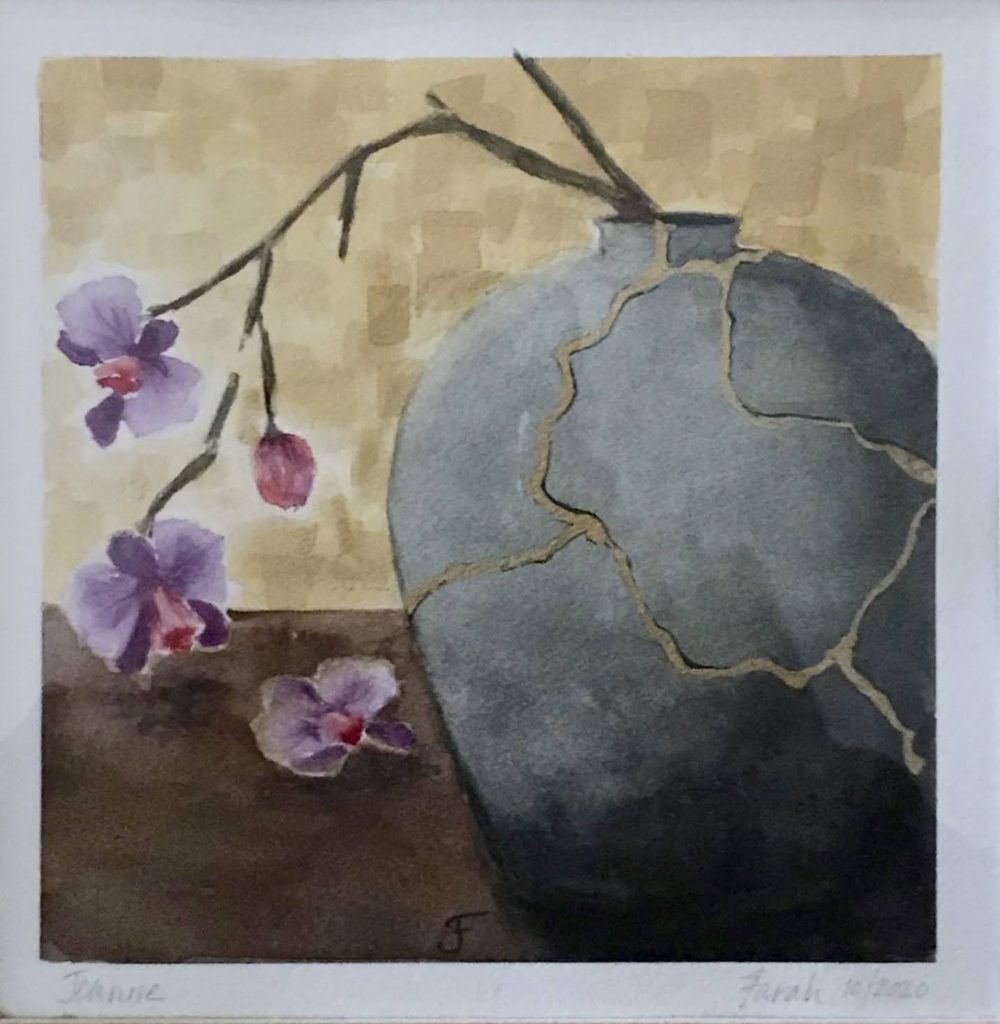
A Broken and Contrite Heart
This was done in the days after Jeanne D’Archer died. I miss her so much. The painting isn’t necessarily about her; it is an image that came to me in a half dream the morning after she died. The image brought to mind a biblical reference that I think of often. The use of gold to repair pottery is a tradition developed in 14th century Korea and Japan. I learned about it in a wonderful YA novel called “A Single Shard.” Watercolor, Jackie Farah

Rhododendron
This was a quickie, completed in 20 minutes or so, during the first month of the pandemic when we all thought it would be over soon – hah! Oil on canvas, Sally Woolley
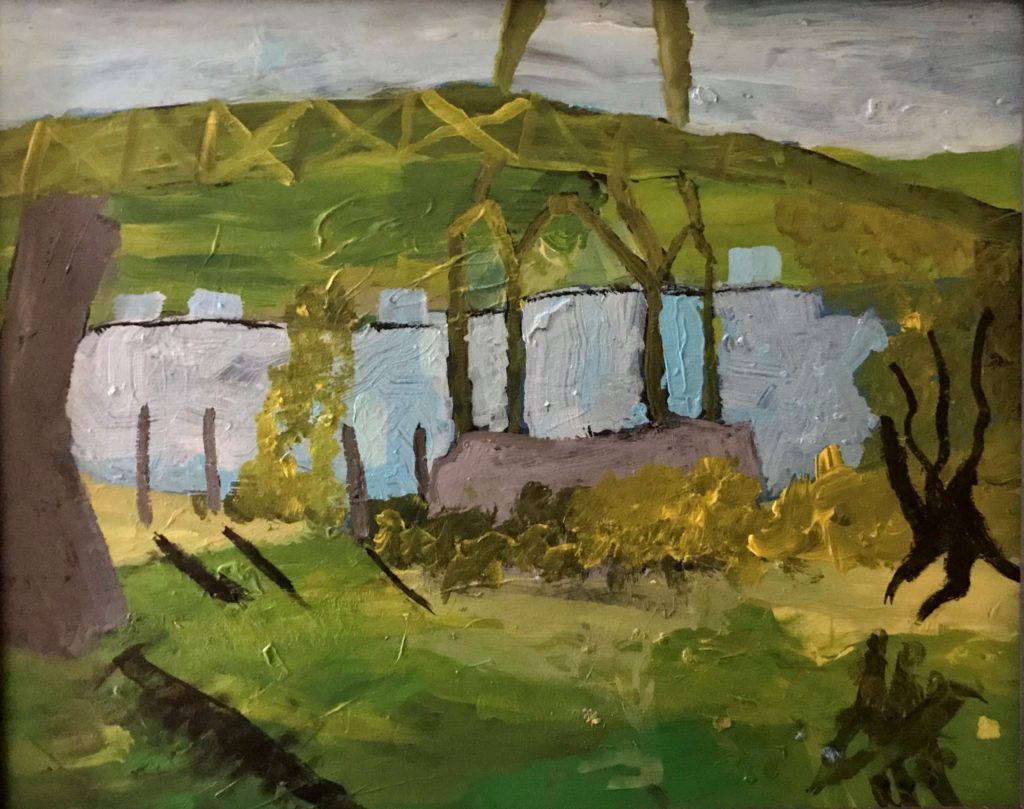
Bridge View
This painting was started at Cathedral Park in the St. John’s neighborhood. I was lucky enough to set up my art easel, and spend a relaxing day painting with my friends in the Westminster open art studio. I was a happy painter that day, I felt like an Impressionist. I will probably return for more painting in the St. John’s neighborhood! Acrylic, Eli Karn

Layered Leaves
Enjoying Portland’s wonderful leaves, inspired by Sunriver teacher/artist Helen Brown. Watercolor, Michal Haller
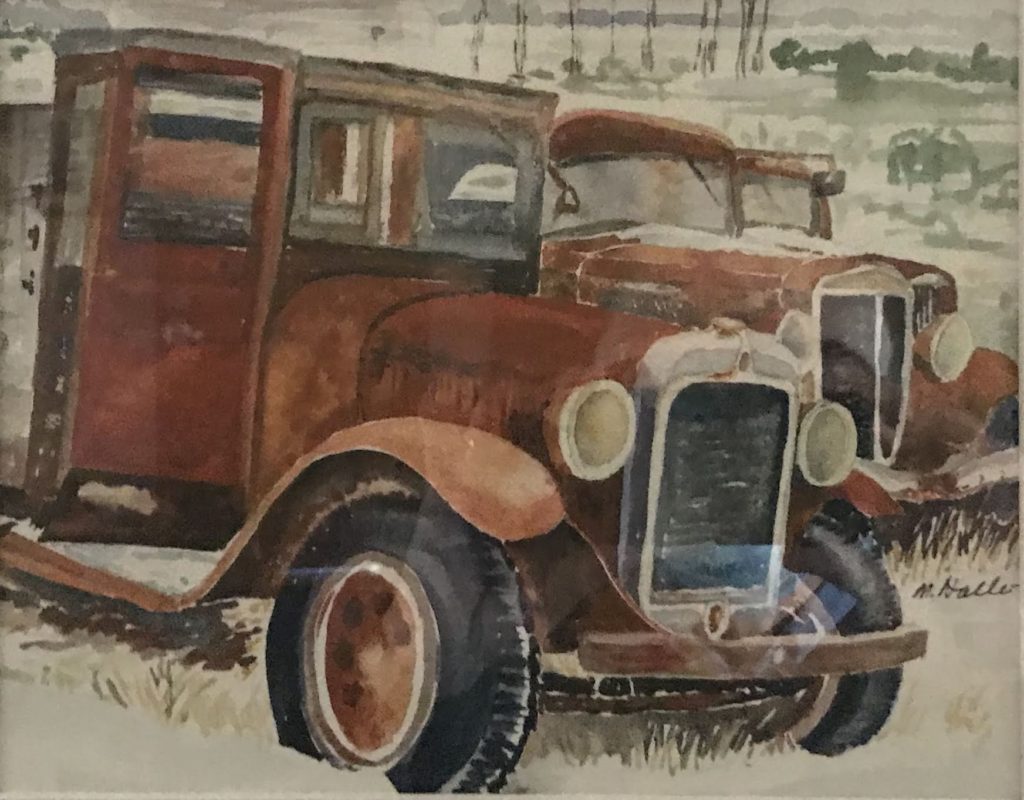
Prineville Trucks
I had this photo in a “to paint” file for at least ten years, but a Cloisters challenge during Covid to paint “vehicles” finally led me to get it out and try painting more detailed than I usually do. And Covid gave me more time to do it. (Count our Blessings) Watercolor, Michal Haller
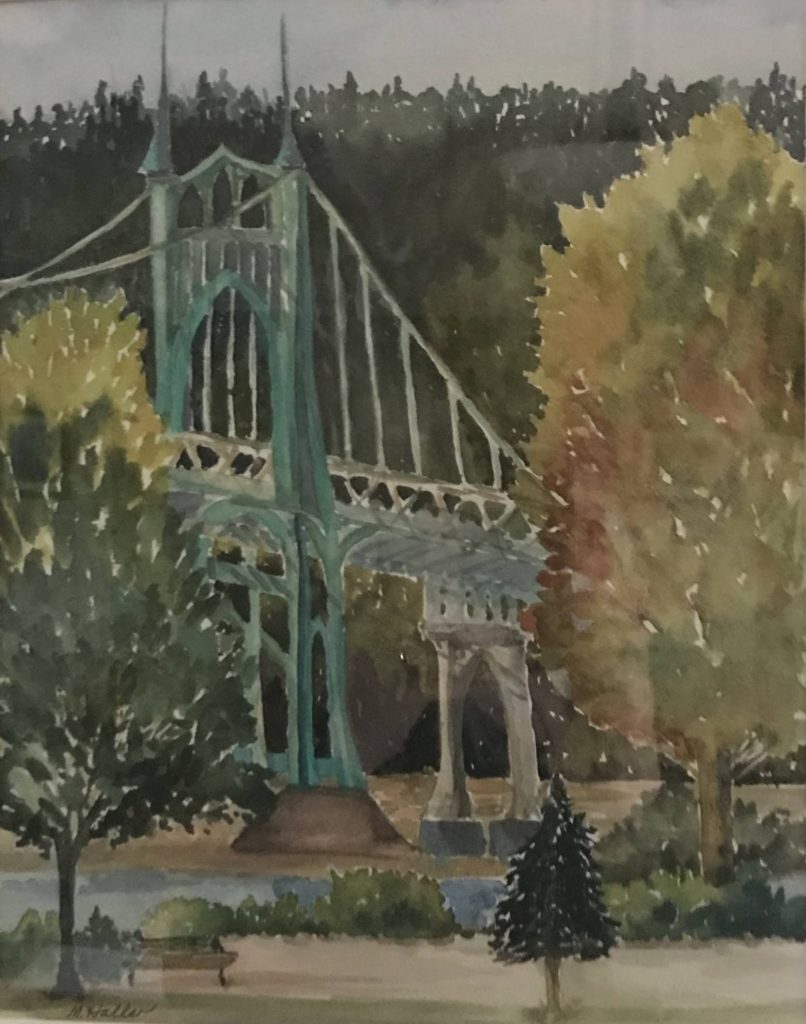
St. John’s Bridge
Our Cloisters group scheduled a Plein air paint out
at Cathedral Park. It was a great way to get outdoors in a socially distant way, to get inspired. I usually find it hard to paint on site, but I was able to draw and paint just the bridge part, then finished the trees at home on another day. Watercolor, Michal Haller
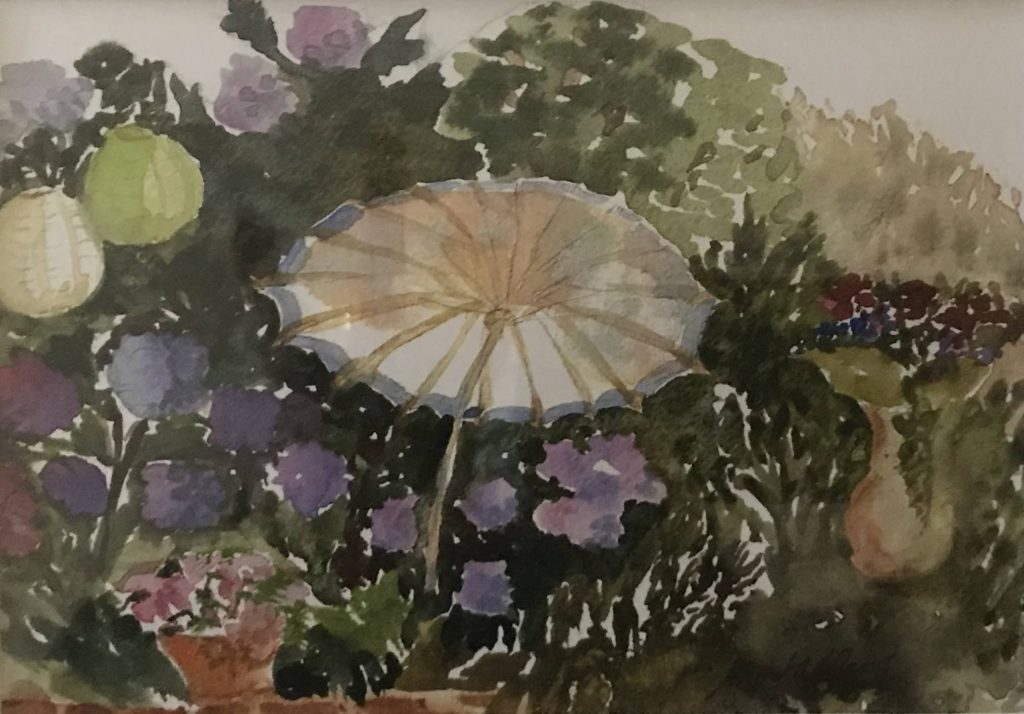
Garden Umbrella
The umbrella was placed in the garden to keep the hydrangeas shaded during a hot sunny spell. Watercolor, Michal Haller
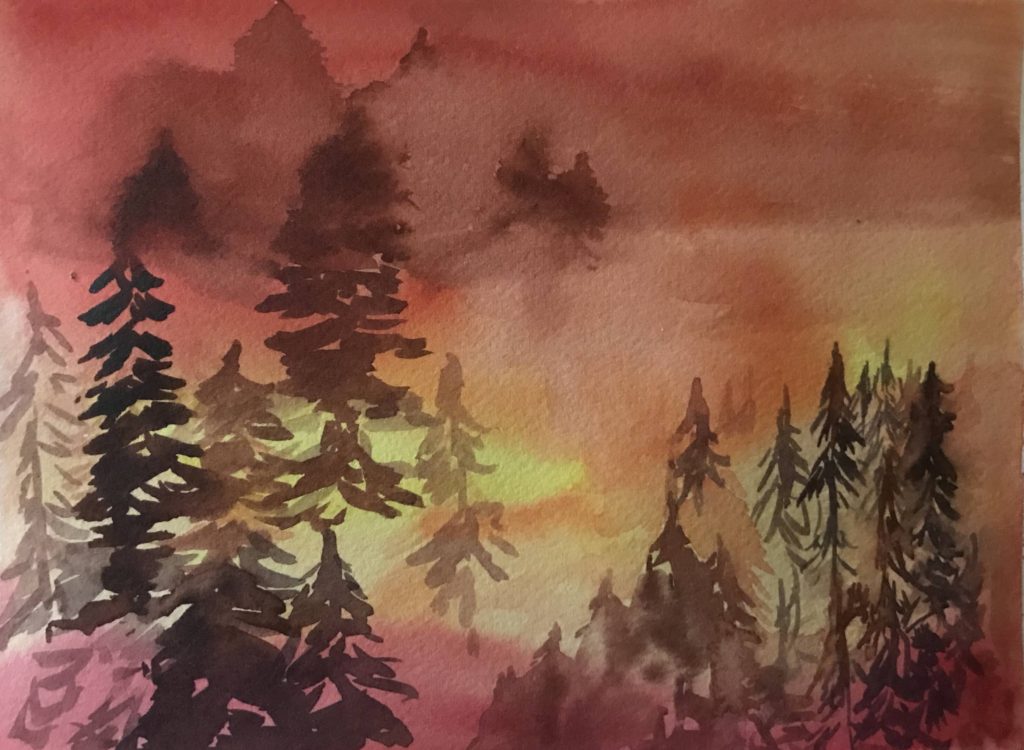
Forest Fire
One of our weekly challenges, during the time of this summer’s fires throughout the west, was to paint an impression of fire and smoke. Watercolor, Michal Haller

Hydrangeas
Painted at our summer Hydrangea Paint Out plein aire session. Oil on canvas board, Sally Woolley
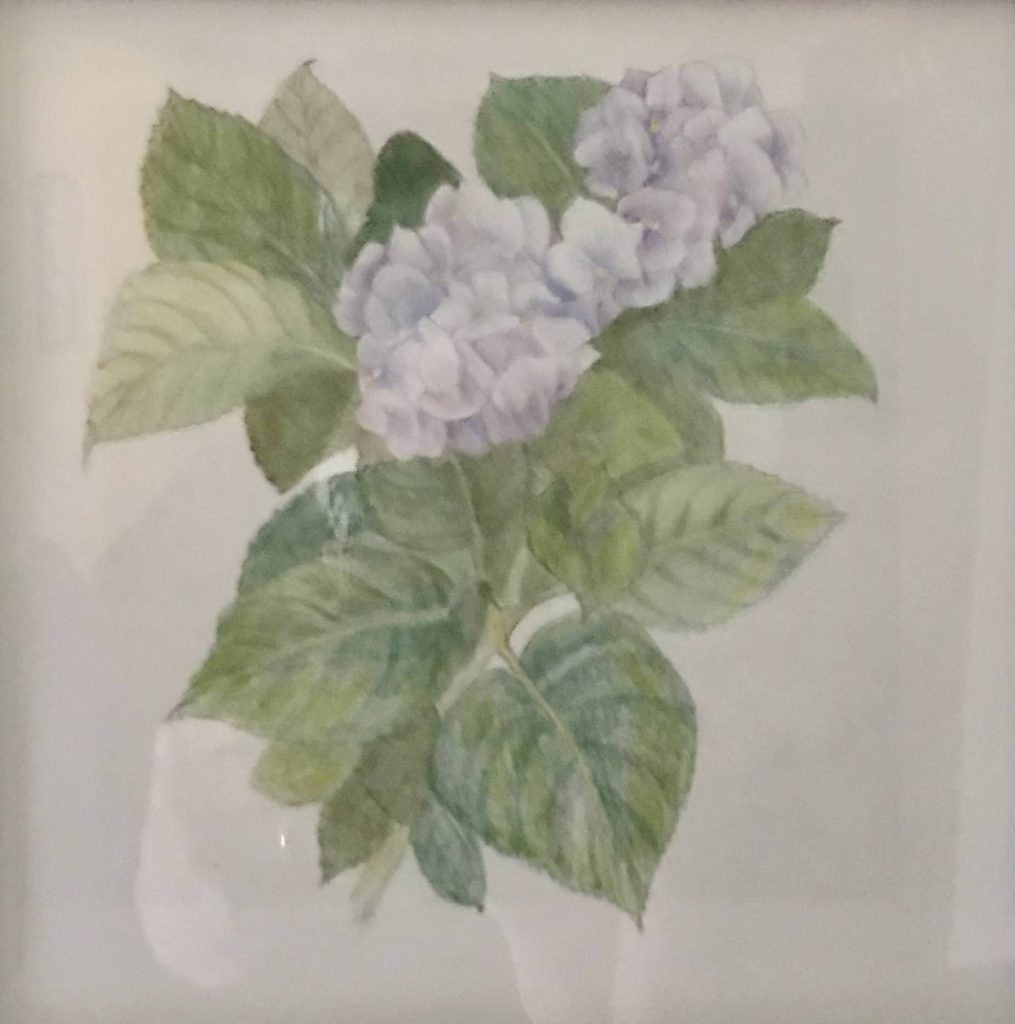
Hydrangea
Jeanne loved nature, observing, drawing, painting, and collecting specimens. She had a huge hydrangea in her own back yard, but one of Sally’s posed for this portrait. Colored pencil, Jeanne D’Archer
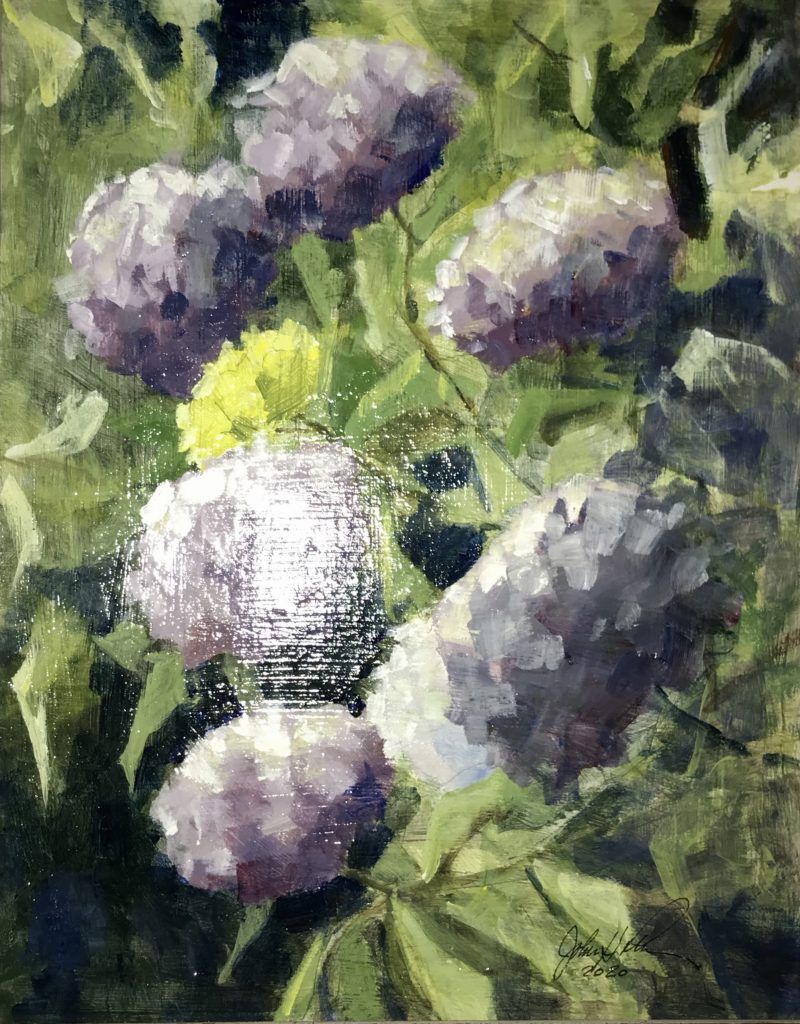
Hydrangeas
During the summer the Cloisters Group has had four paint outs. I completed this painting during a paint out in Sally Woolley’s backyard – she has lots of hydrangeas. It was done quickly and I like the “loose” result. Acrylic, Jack Robinson
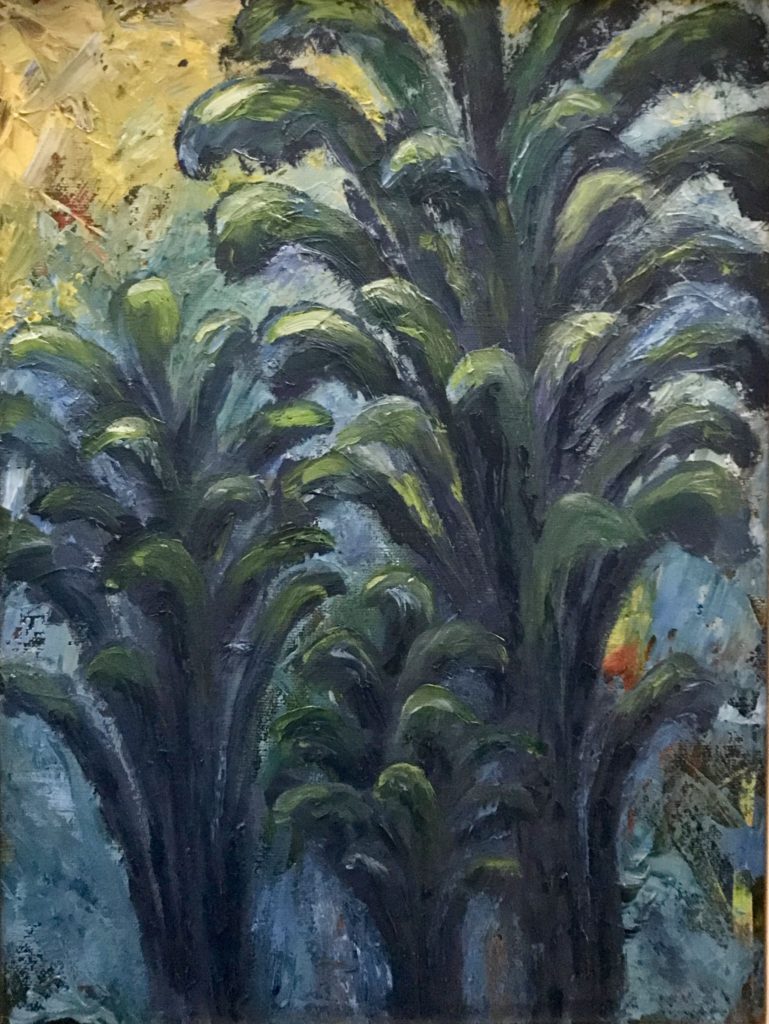
Kale
The only way I like kale is in a painting! This kale was growing in my neighbor’s garden. I don’t like to eat it, but it’s a gorgeous plant. I used the same playful background technique as with Summer Triptych. Oil on canvas, Sally Woolley
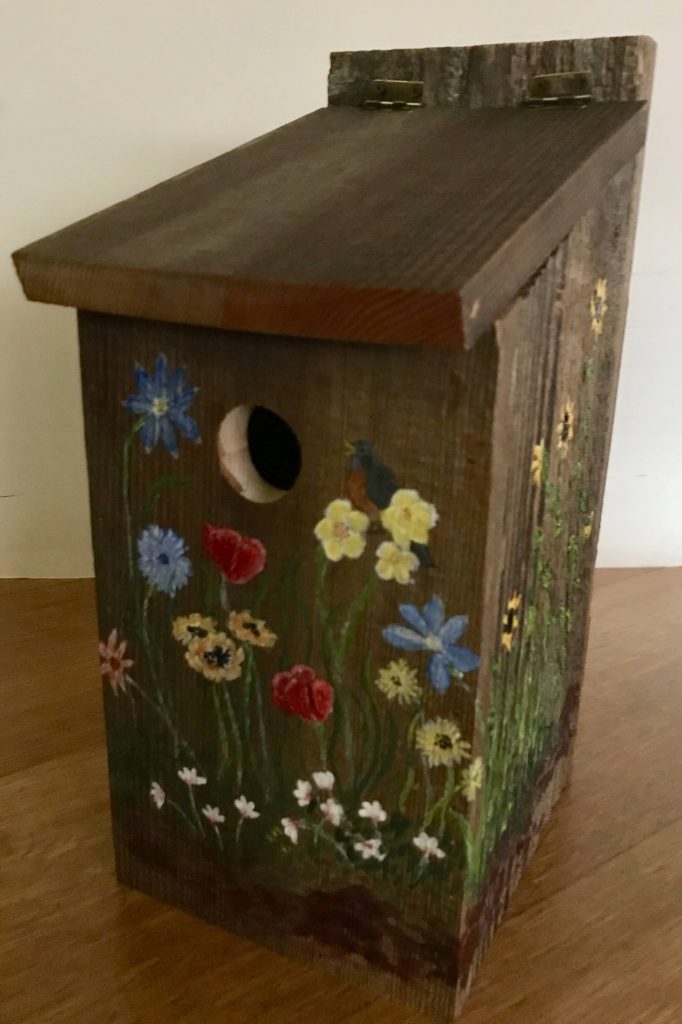
Wildflower Birdhouse
I just made up flowers that would work in the small size and on the rough board. The sunflowers on the sides seemed like the best thing I could do with those extremely rough boards. Mixed media: cedar, acrylic paint, oil-based Urethane, Cynthia Bauer
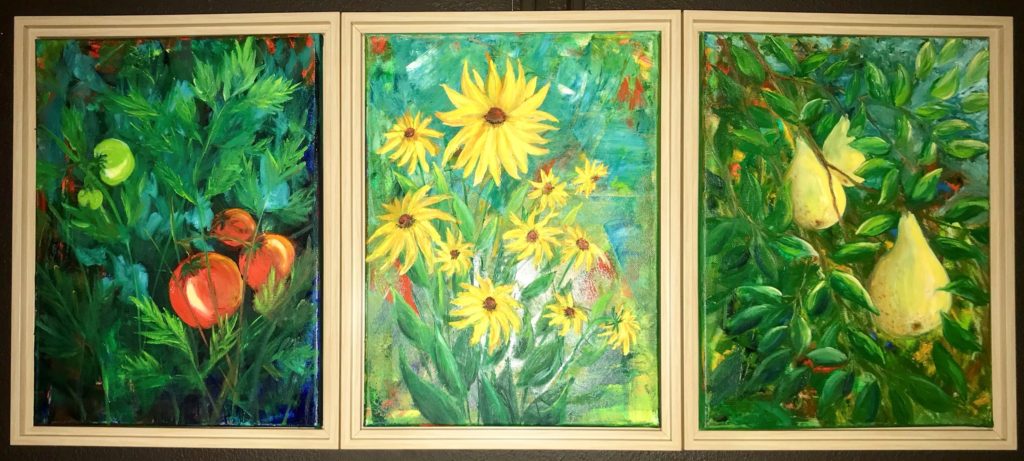
Summer Triptych
Nothing says summer like home grown tomatoes, black-eyed Susans, and beautifully ripe pears. I was experimenting with a different background technique. Oil on canvas, Sally Woolley
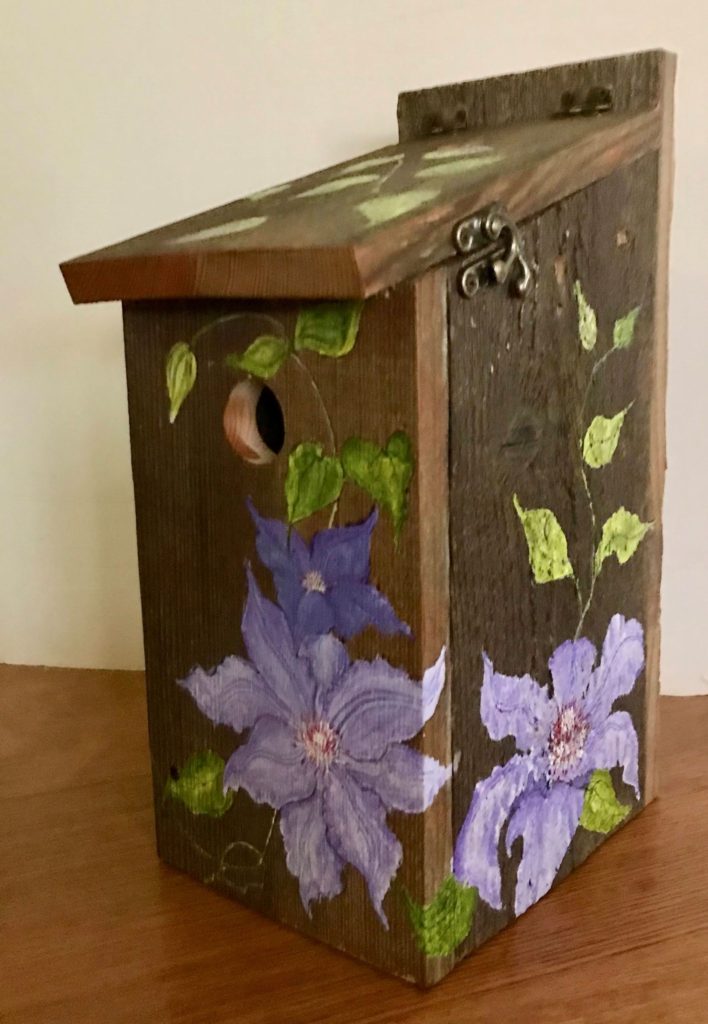
Clematis Birdhouse
The image on this chickadee birdhouse is roughly of a Ramona clematis, which I have growing along a cedar fence. I intend to hang the birdhouse among the real foliage, just for fun. I’ve love finally having a neighbor-cat-less yard in which to feed birds. The birdhouses were a logical outcome to my new interest in small carpentry. Ever the recycler, I used ancient cedar fence boards saved from the dump and only materials I had on hand. Though I loved the very rough silvery look of the weathered boards, I hadn’t thought through how hard they would be to paint on. Careful details were impossible, so it was an exercise in accepted imprecision. Cynthia Bauer
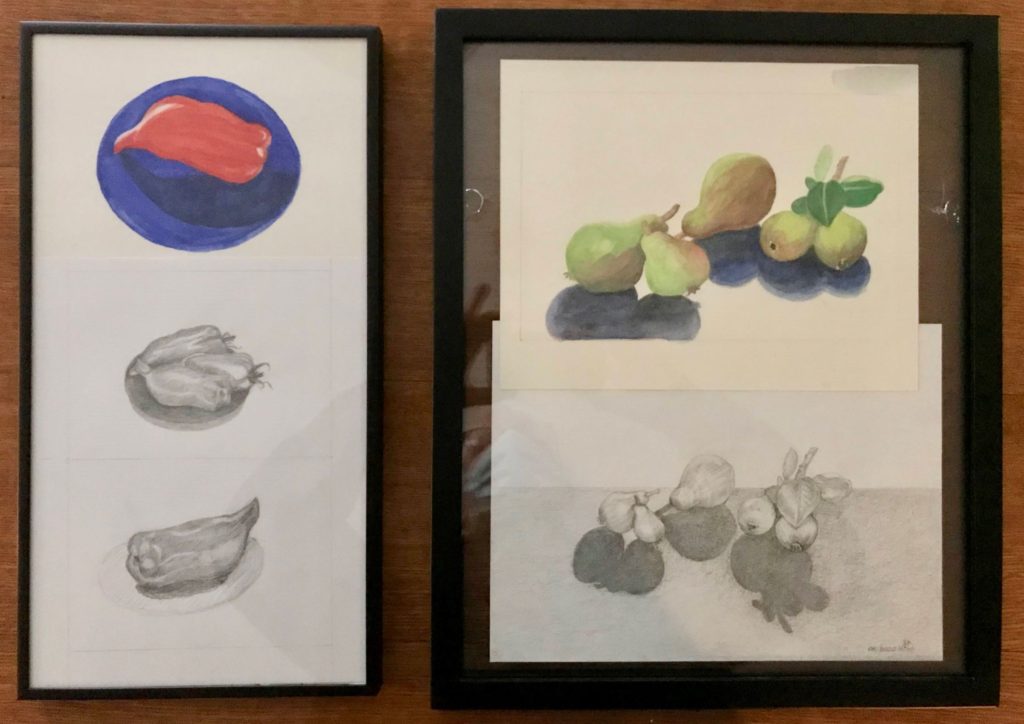
Pears and Paste Tomatoes (2 montages)
Jeanne’s interest in photography shows in her pencil drawings. These became value guides for her painting, but were more than tools for the use of color. They are works on their own, as demonstrated by her signature on the pears, the only of her last few works that she signed. Pencil and water color, Jeanne D’Archer


